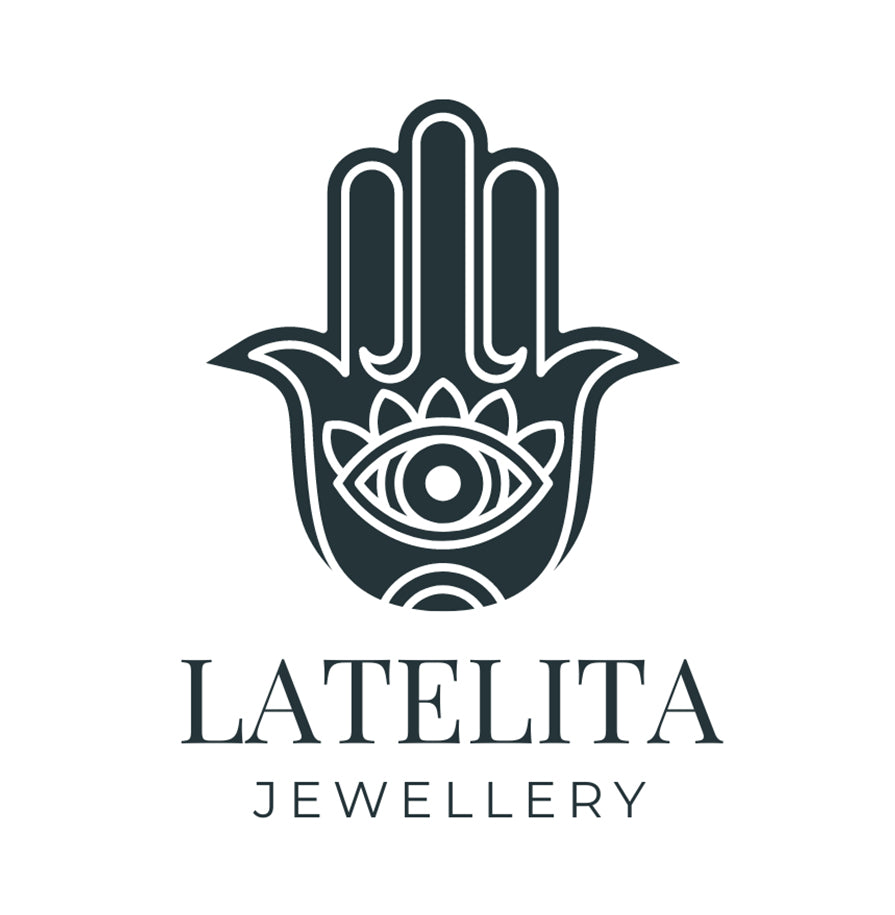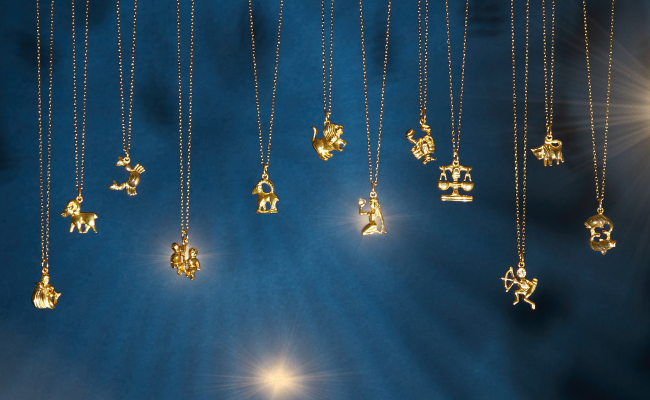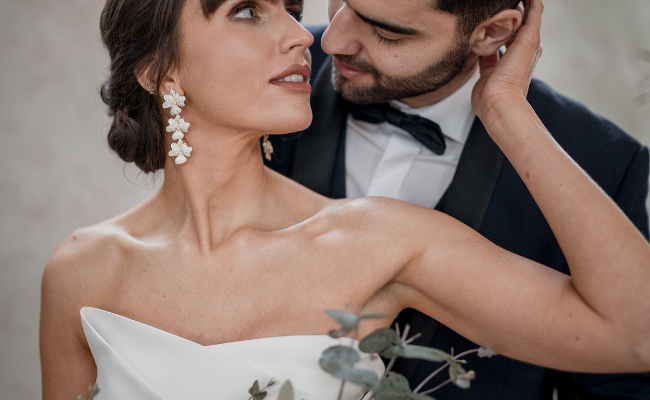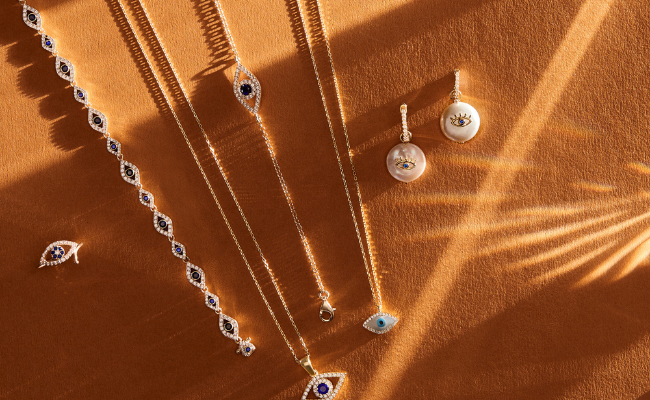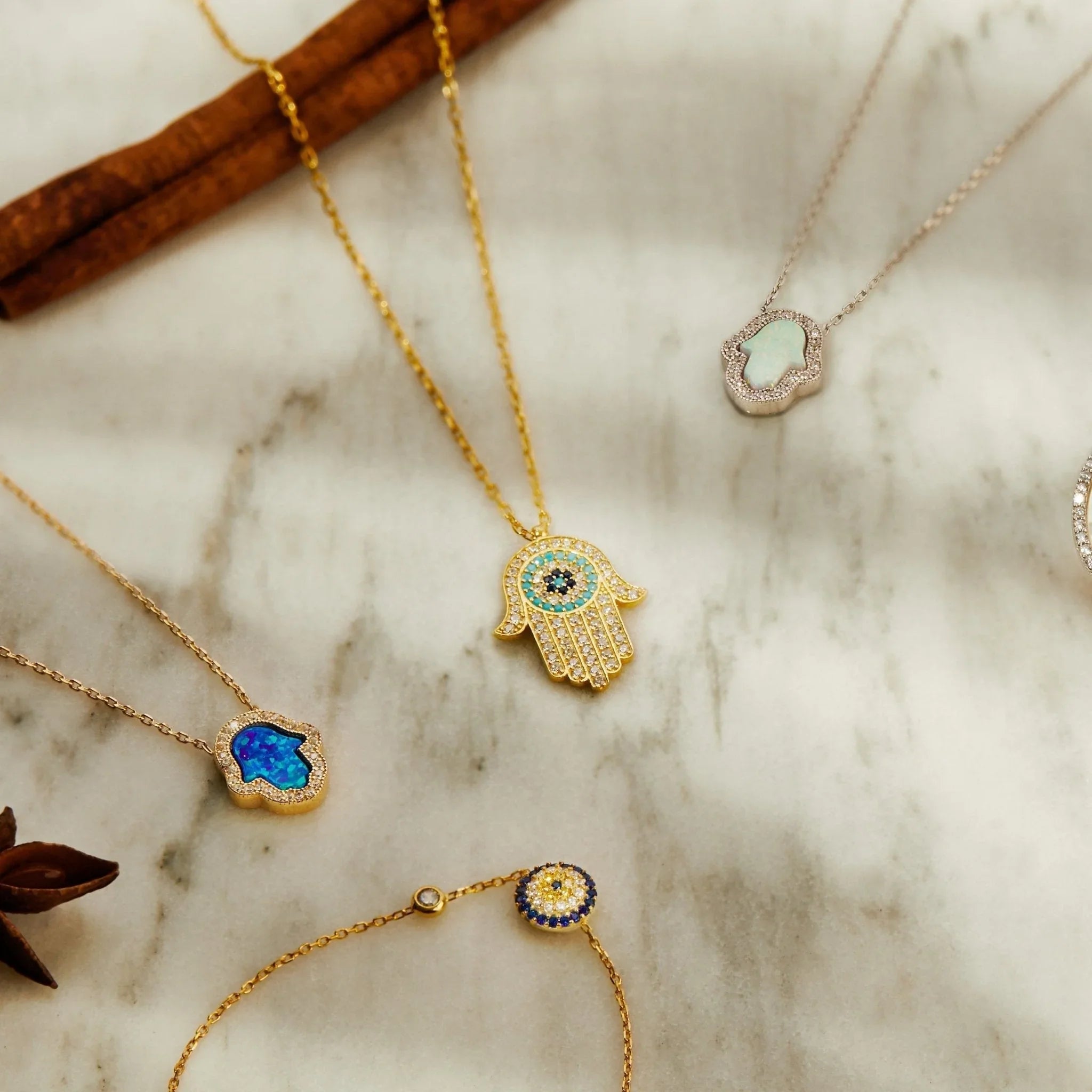
Evil Eye Meaning: What is the meaning of the Evil Eye & Hamsa Hand in Jewellery?
Evil Eye Meaning:
So, what does the evil eye actually mean? The "evil eye" is a belief found in many cultures that someone can cause you harm — like bad luck, illness, or other misfortune, just by looking at you with jealousy or ill will. People often wear charms, usually shaped like a blue eye, to protect themselves from this negative energy.
Where does the evil eye originate from
The evil eye is said to have originated in ancient Mesopotamia some 5000 years ago, where it was used as a way to ward off evil spirits. The concept of the evil eye then spread to Assyrians and Phoenicians, Celts, the Hellenistic Age, Romans, Jews through the Bible to modern times.
It is also mentioned in a cuneiform from the Sumerians, who advised water treatments against it. The ancient cuneiform discovered in Mesopotamia reads, ‘The ad-gir, the man's eye...' Unto heaven one goes, and storms are raised to rain.’ Another Sumerian cure for the evil eye was to wash the eyes with special dirt.
Evil eye continued to be popular among different cultures, and observed in Greek, Roman, Jewish, Islamic, Buddhist, and Hindu cultures as well as indigenous, peasant, and other folk societies throughout history.
The History of the Turkish Evil Eye
The evil eye is a popular belief in many cultures, including Turkey.
The evil eye is said to be the cause of bad luck or misfortune, and is often given by people who are jealous of others' success. The evil eye is traditionally represented by a blue eye, and is often used as an amulet to ward off evil spirits.
The Turkish people created the Nazar Boncuk charm, also known as the Turkish evil eye, to protect themselves from the harm of the evil eye. Jewellery was fashioned to represent the evil eye in earrings, bracelets, necklaces, rings and amulets. The purpose of the amulet is to keep you safe from harm and drive away bad spirits.
It's not about finding good fortune; it's all about defending yourself.
People then started to hang the pendant on everything from their pets to their children. They are frequently worn around one's person and placed throughout the house as a form of protection.
Whether you believe in the evil eye or not, it's clear that this belief has a long history and cultural significance in Turkey.
Evil Eye Large Pendant
Our Latelita evil eye pendant is designed in the form of a disc and adorned with rings of colourful zircons depicting the evil eye talisman.
What does the Evil eye symbolise
The evil eye is a curse believed to be cast by a malevolent glare, usually given to a person when they are unaware. Many cultures believe that receiving the evil eye will cause misfortune or injury.
Evil eye jewellery and Hamsa jewellery are both popular choices for those who want to protect themselves from negative energy. Both evil eye and Hamsa jewellery are said to offer protection against the evil eye, which is a negative force that can cause harm.
The Eye of Horus
In ancient Egyptian the eye of Horus is a symbol of protection, royal power and good health. The eye is personified in the goddess Wadjet and associated with the sun god Ra. The Eye of Horus is similar to the evil eye symbol, which also represents protection.
Eye of Horus Silver Earrings
These Latelita earrings are inspired by ancient Egyptian hieroglyphics and is still a common symbol worn or displayed to keep away the evil eye and to bring good luck.
Evil eye in different cultures
The phrase "evil eye" has a variety of meanings throughout many civilizations. The essence is that the curse of someone with more power and prosperity in life. However, there are some intriguing interpretations we'll go through below.
Hinduism
Even a look of admiration could be enough to bring the evil eye curse down on another person, according to Hindus. Their cow's milk production would dry up as a result of this, and they would be unable to survive. As a consequence, there was a custom in Hindu culture where you offer someone you respect a bowl of milk as an antidote for the evil eye.
China
The evil eye is also a popular belief in China. If you give someone a compliment, it's customary to add the phrase "bi zuo" (??) or "no evil eye" at the end. This is to protect the person from receiving the evil eye from others who may be jealous of them.
South America
In Brazil, the superstition is called the “fat eye” rather than the evil eye. They believe it goes after those who have received insincere compliments. If you’re given a sincere compliment, then you’re fine.
Europe
In Europe, the belief in the evil eye was especially strong during the Middle Ages. Many people believed that witches had the power to cast evil spells with their eyes. In order to protect themselves, people began wearing amulets and charms. Today, the evil eye belief is still alive and well in many parts of the world. It's also seen as a symbol of good luck in some cultures.
The evil eye is also known as the "malocchio" in Italian, "matar ojo" in Spanish, and " ayin horeh" in Hebrew.
Today, the evil eye is still a popular belief, and there are many people who wear amulets as protection against the evil eye.
How can evil eye and Hamsa jewellery protect you
One of the most common ways to ward off the evil eye is to wear an amulet or talisman known as a Hamsa. The Hamsa is a hand-shaped symbol that has been used for centuries to protect against evil. The word "Hamsa" comes from the Arabic word for "five," and the evil eye Hamsa typically has five fingers or points. Today, the evil eye is still a powerful Symbol with a deep meaning and significance. It is also a reminder that we should be aware of our own actions and thoughts, and how they can impact others.
Cosmic Hamsa Necklace
A Latelita modern take on an ancient amulet, the Hamsa necklace is forged from a single piece of sterling silver, each Hamsa is carved by hand.
.
Some people believe that evil eye and Hamsa jewellery can protect them from the evil eye curse, and that by wearing evil eye and Hamsa jewellery this will offer protection against the evil eye curse. Others also believe that evil eye and Hamsa jewellery can protect them from negative energy.
Evil eye bracelets, necklace and rings are popular choices for those who want to protect themselves from negative energy. Both evil eye and Hamsa jewellery are said to offer protection against the evil eye.
Evil Eye Elliptical Bracelet
This petite Latelita evil eye elliptical bracelet is perfect for those who love delicate jewellery. The chain bracelet features an eye motif that is adorned using Latelita London multifaceted white zircons, which encompasses a single sapphire blue zircon.
The evil eye is worn as a sign of protection against the jealous glare.
Protecting Yourself Against the Evil Eye
There are a variety of methods to avoid the evil eye that don't include charms. The Greeks burned incense and carried crosses for protection. Brand new moms would place protective items, such as gunpowder, a nail, and garlic, under their pillows.
In some areas, people burned bear fur to get rid of the evil eye. Christians in European countries would create a cross with their hands while pointing their pinky and index finger toward the curse’s origin. These are only a few supposed healing and prevention methods.
What is the difference between evil eye and Hamsa jewellery
Hamsa jewellery is often more ornate and decorative than evil eye jewellery, which is usually more simplistic. Evil eye jewellery is also said to provide protection from evil forces, while Hamsa jewellery is said to bring good luck.
Evil eye jewellery is typically made with blue enamel or glass, and often has a evil eye charm or symbol on it. Hamsa jewellery, on the other hand, typically features a hand-shaped charm or pendant. Both evil eye and Hamsa jewellery can be found in bracelets, necklaces, and earrings.
Here are some examples from our Latelita jewellery collection
The Hamsa can be worn facing up or down and it is believed to give the owner success, harmony, and protection from the “Ayin Ha’ra,” also known as The Evil Eye.
Hamsa Opalite Turquoise Blue Necklace
This Hamsa necklace is great for everyday styling, and is popular amongst our regulars shoppers as a addition to their favourites.
An iridescent Opalite Hamza gemstone adds a pop of colour, and is accentuated by a row of sparkling zircons, which catch the light dazzling from day to night.
Hamsa Hand Bracelet
The Hamza hand (Arabic) or Hamish hand (Hebrew) is an old and still popular apotropaic amulet for magical protection from the envious or evil eye Nazar. The words Hamsa and Hamish mean "five" and refer to the digits on the hand
Hamsa Hand with Evil Eye Pendant Necklace
This simple yet chic, Hamsa hand necklace is perfect for everyday styling. Either worn singularly or layered for a more dramatic look.
Elliptical Eye Band Ring
Pretty and petite, this evil eye inspired ring is perfect for those who covet delicate jewellery.
This ring makes for an ideal birthday gift, especially to lovers of gemstone and delicate jewellery, amulets and charms.
Evil Eye Elliptical Necklace Blue
This petite evil eye elliptical necklace with blue gemstone is perfect for those who love delicate jewellery.
Evil Eye Bracelet Gold
This simple yet chic evil eye bracelet has a ring of blue gemstones with white and gold CZ and blue gemstone adorning the centre for the perfect Evil Eye look.
Heart Evil Eye Bracelet
This pretty bracelet features an open heart motif outlined with zircon with a larger crystal at its centre sitting alongside an evil eye motif.
How to wear evil eye and Hamsa jewellery
You can wear evil eye and Hamsa jewellery as a bracelet, necklace, earrings or even a ring. Some people also like to hang evil eye and Hamsa charms in their homes or cars. Evil eye and Hamsa jewellery can be worn as a stand-alone piece or as part of a layered look. If you're looking for protection from evil forces, consider wearing evil eye jewellery. If you're hoping to attract good luck, consider wearing Hamsa jewellery.
When it comes to evil eye and Hamsa jewellery, it's up to you to decide what you believe and what you feel comfortable wearing. If you're looking for protection or good luck, consider evil eye and Hamsa Latelita jewellery as an option.
Latelita Open Hamsa Turquoise Necklace Gold
Today, the Hamsa is worn by people of all faiths as a protection against evil.
Whether you believe in the evil eye or not, it's fascinating to learn about the history and culture surrounding this ancient belief.
Reason for the blue Colour and what materials are used
The evil eye is comprised of two primary colours, blue and light blue.
Blue is the colour of protection, with yellow or light blue in the centre. The protector, which is generally black, is centred on a blue background.
The colour blue has the ability to radiate good karma and is associated with positive energy.
The sky is generally depicted in light blue. This shade of evil eye charm is a sign of truth. In ancient history, blue stood for God in the sky, and it has the capacity to relieve tension after being examined.
So, which one should you choose? It really depends on your personal preference.
If you like the look of evil eye jewellery, then go for it! If you prefer the look of Hamsa jewellery, then that’s a great choice too. Either way, you’ll be protecting yourself from negative energy with these beautiful pieces of jewellery.
The evil eye is a powerful symbol with a long history. If you’re looking for something to give you a boost of positive energy, look no further than the good old evil eye.
Our LateLita collection has plenty of different pieces to choose from so you can find the perfect one for you, your loved ones and friends, and bring a little piece of happiness and positivity in to our lives.
And don’t forget, if you have any questions about our jewellery or anything else, we’re always here to help.
Visit our web site at https://www.latelita.com/
Thanks for reading and I hope you enjoyed the blog.
